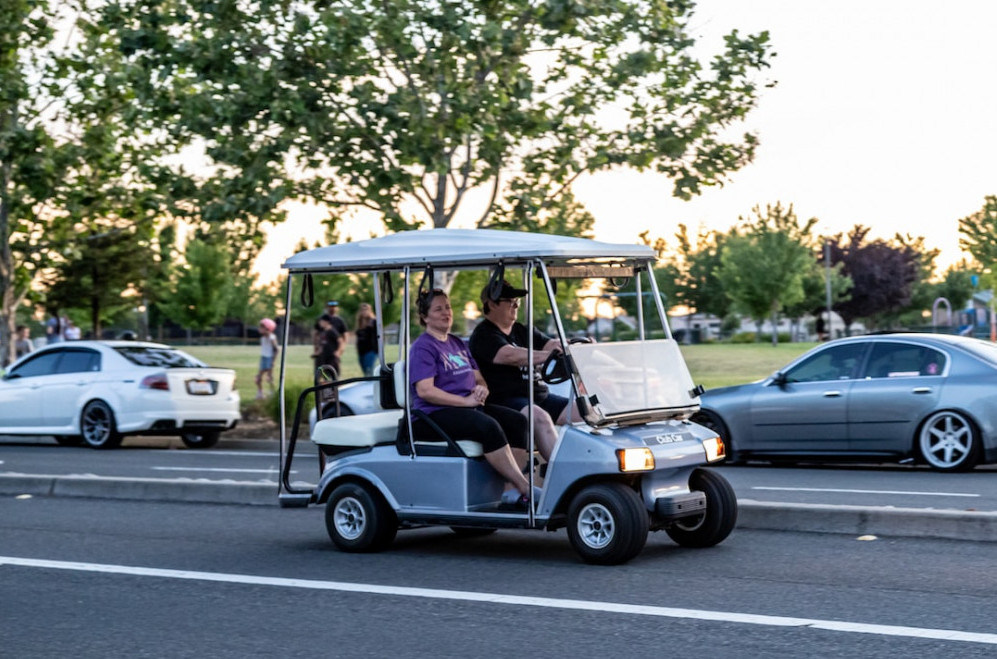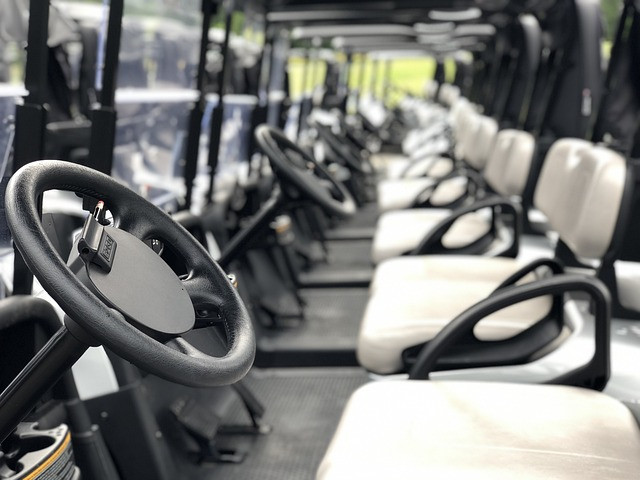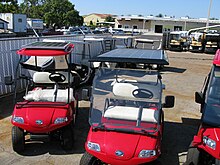
.
A golf cart (alternatively known as a golf buggy or golf cart is a small motorized vehicle designed to carry two golfers and their golf clubs around a golf course with less effort than walking. Over time, variants were introduced that could bring more passengers, had additional utility features, or were certified as street-legal low-speed vehicles.
A traditional golf cart, capable of carrying two golfers and their clubs, is generally around 4 feet (1.2 m) wide, 8 feet (2.4 m) long and 6 feet (1.8 m) high, weighing between 900 and 1,000 pounds (410 and 450 kg) and capable of speeds up to about 15 miles per hour (24 km/h).
The price of a golf cart can range anywhere from under US$1,000 to well over US$20,000 per cart, depending on how it is equipped.
Reportedly, the first use of a motorized cart on a golf course was by JK Wadley of Texarkana, who saw a three-wheeled electric cart in Los Angeles to transport senior citizens to a grocery store.
Later, he purchased a cart and found it worked poorly on a golf course. The first electric golf cart was custom-made in 1932 but did not gain widespread acceptance. From the 1930s until the 1950s, the most pervasive use of golf carts was for those with disabilities who could not walk far.
Why Golf Carts
Golf carts are versatile and can be used for leisure, transportation, commercial work, and, of course, golf. They are affordable, fuel-efficient, environmentally friendly, easy to store, and easy to transport. Golf carts play an essential role at many golf facilities.
They provide a revenue source and increase accessibility, allowing golfers who might not otherwise be able to walk the course to enjoy playing Golf carts can also be an excellent solution for folks who are disabled or have a bit of a hard time getting around.
However, it’s important to note that golf carts can negatively impact turf health and playing conditions, especially in areas where traffic is concentrated Keeping these things in mind will help ensure that you don’t put the cart before the course during your next round.
Golf was yet to become a trendy pastime sport, and many golf courses resisted it for financial reasons. Others didn’t want carts because they were worried about how they may tear up or damage their golf course. That’s because early golf carts were less smooth in operations than today
Though electric, like many modern models, they ran less effectively and took more battery power to get where they wanted.
Even worse, they often ran out of power on a golf course because battery maintenance was a new concept. As a result, they were often considered more of a hassle than they were worth and only used in particular circumstances and by higher-end golf courses.
However, the implementation of better battery and steering systems in the 1950s helped to make golf carts more versatile equipment. At this point, they had become a more popular choice for golf courses that wanted to help golfers who couldn’t walk long distances.
This use helped to open up golfing to a broader audience, and this was when seniors started flocking to the sport. and at this point, multiple manufacturers were producing electrical models, including surprising companies like Sears Roebuck and Victor Adding Machine Company.

An Important Innovator of the golf cart- Merle Williams
Merle was an engineer designer who had already begun experimenting with electrical carts as early as World War 11. He desired to create a simple cart to cut down on gasoline use, which was rationed during this time., and allow people to get where they wanted to go in their hometown.
These carts fueled the early success of Williams Marketer Company, though Williams was always looking to expand his potential market to focus on different areas.
Types of golf carts
Utility vehicle
 Extreme off-road golf cart
Extreme off-road golf cartMany golf cart manufacturers offer models configured as small utility vehicles (UTV), side-by-side. Initially developed for golf course operations, these UTVs were available with small pickup beds, flatbeds, dump-style beds, van boxes, or coolers and cabinets for drink and snack sales.
With the growing popularity of the side-by-side, many manufacturers are now offering models equipped for use on rugged, off-road terrain.
Transport vehicles
Many golf cart manufacturers offer models configured as vehicles with no provision to carry golf bags. These vehicles are often used in low-speed, off-road applications on school campuses, resort properties, or inside airport terminals.
These transport variants can range from a simple conversion of a traditional golf cart, swapping the golf bag carrier for a second rear-facing seat, to a stretched cart offering additional rows of seating for 4, 6, or 8 people.
Solar-powered golf carts
 Helios Chargers, 130 watts and 205 watts, on solar powered golf carts
Helios Chargers, 130 watts and 205 watts, on solar powered golf carts
Solar golf carts are powered by mounting a photovoltaic panel on top of the cart. A controller converts the sun’s energy to charge the cart’s battery pack. Not only does solar power take the cart off the electric grid, it also increases the driving distance.
Solar conversion kits have been available for golf carts and low-speed vehicles (LSV) for several years. These kits range from low-wattage solar battery chargers to a 410-watt array on an 8-passenger transport cart. Kits utilizing flexible solar panels are often preferred on golf carts due to their light weight and ability to conform to the shape of the cart roof. Buyers can take a solar tax credit of 30% of the purchase price on their US Federal Income Tax.
Solar-powered golf carts are popular with owners who drive long distances, such as maintenance workers, golf course fleets, staff at the Detroit Zoo vehicles in resorts and cities, and drivers of VIP carts on college campuses. High schools have used them as teaching tools for solar power.
These kits range from low-wattage solar battery chargers to a 410-watt array on an 8-passenger transport cart. Kits utilizing flexible solar panels are often preferred on golf carts due to their light weight and ability to conform to the shape of the cart roof. Buyers can take a solar tax credit of 30% of the purchase price on their US Federal Income Tax.
Solar-powered golf carts are popular with owners who drive long distances, such as maintenance workers, golf course fleets,] staff at the Detroit Zoo, vehicles in resorts and cities, and drivers of VIP carts on college campuses. High schools have used them as teaching tools for solar power.
Golf cart communities
 Sharrows indicating that golf carts share the road in Ave Maria, Florida
Sharrows indicating that golf carts share the road in Ave Maria, Florida- Peachtree City, Georgia, has many miles of golf cart paths that link the city together. Children aged twelve or over may operate a cart on Peachtree City paths with a parent, grandparent, or guardian in the front seat. Unaccompanied fifteen-year-olds with valid Georgia learner’s permits can drive golf carts alone. Golf cart travel is used by a great majority of the community, especially among high school students. McIntosh High School and Starr’s Mill High School have student golf cart parking lots on their campuses.
- On Certain islands (such as Santa Catalina Island, California; Bald Head Island, North Carolina; North Captiva Island, Florida; and Hamilton Island, Queensland, Australia), motor vehicles are sometimes restricted, and residents use golf carts instead.
- The Villages, Florida, a retirement community of over 70,000 people, has an extensive golf cart trail system (estimated at 100 miles (160 km)) and allows golf carts on many streets. It is the most popular form of transportation in this community.
- On the tropical islands of Belize, golf carts are a significant form of road transport and can be rented by tourists.
- The residential community of Discovery Bay, Hong Kong, does not allow the use of private vehicles apart from a fleet of 520 golf carts (excluding the ones operating exclusively in the Golf or the Marina Clubs). The remainder of the 20,000 residents rely on a mixture of shuttle buses and hire cars to travel around the township.
- The Palm Springs Area in California contains multiple golf cart communities, including PGA West, The Madison Club, The Hideaway, and many other golf course/golf cart communities. The PGA Tour is held at PGA West every January.
Safety
Along with the rising injury in golf cart crashes, the number of golf cart-related injuries has increased significantly over the past years. A study conducted by
researchers in the Center for Injury Research and Policy of The Research Institute at the Nationwide Children’s Hospital found that golf cart-related injuries rose 132% during the 17-year study period. According to the study published in the July 2008 issue of the American Journal of Preventive Medicine, there were 148,000 golf cart-related injuries between 1990 and 2006, ranging from an estimated 5,770 cases in 1990 to approximately 13,411 points in 2006. More than 30% of golf cart-related injuries involved children under 16.
The most common type of injury was soft tissue damage, usually just bruises, followed by fractures, constituting 22.3% of the cases, and lacerations, accounting for 15.5% of injuries. Other injuries include concussions, internal injuries, subdural hematoma, spinal cord injury, or acute respiratory compromise. While rare, a few cases had severe outcomes: 4 fatalities, two paraplegics, and one quadriplegic damage have been documented.
Some leading causes of injury related to golf cart accidents included cart overturn, falling/jumping from a moving golf cartwort, collision with another vehicle or stationary object, being struck/run over by a coach, and getting into or out of a cart. Of all these, “falling or jumping from a golf cart” was the most common cause of injury for adults and children
.
One contributing reason is that current golf cart safety features are insufficient to prevent passenger falls or ejection. Golf carts moving at speeds as low as 11 miles per hour (18 km/h) could readily eject a passenger during a turn. Furthermore, rear-facing golf cart seats are associated with high rates of passenger ejection during fast acceleration, and most standard (stock) golf carts do not have brakes on all four wheels (typically, brakes are only on the rear wheels, thus sharply limiting their braking power).
Golf cart injuries are commonly found in desert areas (e.g., Johnson Valley, California). Driving golf carts on bumpy dirt trails, along cliffs, and down rocky trails that should only be traversed using 4-wheel-drive vehicles can all lead to injuries.
The History of Golf Carts and Their Evolution
Golf
carts have existed since the 1930s when they first appeared as
motorized alternatives to the traditional pull-cart. Over the decades,
these vehicles have evolved from basic, practical modes of
transportation to luxurious, high-tech entertainment centers.
Here’s a look at the history of golf carts and their evolution.
The first golf cart was invented in the 1930s by Dallas-based
inventor Virgil D. Gulley. His invention, dubbed the “Gulley Motorized
Golf Cart,” was a small, two-seater vehicle powered by a gasoline
engine. The car was designed to help golfers get around the course
more quickly, and it became an instant hit.
In the 1950s, golf carts began to be powered by electric motors.
These electric golf carts were quieter and more efficient than
gas-powered models, which helped make them even more popular. By the
mid-1960s, golf carts had become a mainstay on golf courses worldwide.
In the 1970s, manufacturers began to develop golf carts with more
features. For example, some models had adjustable seats, cup holders,
and storage compartments. This made golfing more comfortable and
convenient than ever before.
In the 1980s, golf carts underwent a significant transformation.
Manufacturers began incorporating features like luxury seating,
stereos, and even drink coolers into their models. This made golfing
more entertaining for many players.
Today, golf carts are available in various styles and
designs. Some are designed for golf courses, while others are for off-road use. Today’s golf carts are outfitted with GPS,
Bluetooth, and USB charging ports. This allows golfers to stay connected and entertained while out on the course.
Golf carts have come a long way since their invention in the 1930s.
From primary, utilitarian vehicles to luxurious, high-tech entertainment
centers, golf carts have evolved
to meet the needs of modern golfers. Whether you’re looking for a basic
model to get around the course or a luxurious model to entertain you
while playing, there’s sure to be a golf cart out there to suit your
needs.
Golf Cart Technology
The basic design of golf carts hasn’t changed much since the early 1950s. They are still typically around 8 feet long, 4 feet wide, and 6 feet high and weigh around 950 pounds on average. Most golf carts also sport an electric, battery-powered engine rather than a gas engine. Even though a gasoline-powered engine would have more horsepower, it never gained as much popularity due to the loud noises and environmentally unfriendly emissions. Club Car even developed a zero-emissions golf cart.
There have also been significant advancements in the battery since the first electric golf cart. In the 1950s, the average golf cart could only complete 18 to 27 holes on a single charge. In the 80s, the number improved to five 18-hole circuits. Today, most manufacturers state their vehicles can make seven to eight trips around a complete course on one charge.
Golf manufacturers today have implemented plenty of 21st-century technology into the new golf carts coming onto the market. Improvements include better ergonomics, increased carrying capacity, and more high-efficiency systems. Many new golf carts boast onboard GPS systems, car tracking, and more powerful battery engines.
With golf carts becoming more common in industrial industries, Cushman and other manufacturers have come out with golf carts that can handle anything from deep gravel to thick mud. Golf carts are no longer used to traverse the golf course but can be used in rugged terrain.
Legislation
Arizona has a large snowbird population, and many live in large RV parks or retirement communities that use golf carts to get around. In 2014,
Arizona Governor Jan Brewer signed a law permitting golf cart drivers to drive as close to the right-hand edge of the roadway as possible. Before the law’s passage, golf cart drivers received traffic tickets for failing to operate in the center of the road. Complementing the new law, a golf cart safety education program was initiated.
Conclusion
Golf carts have come a long way from their initial use as a tool for elderly golfers. Golf carts are now a staple in golf and are used for many services outside the game. The significant popularity of golf carts has led the industry to blossom to an astounding 2 billion dollars.
